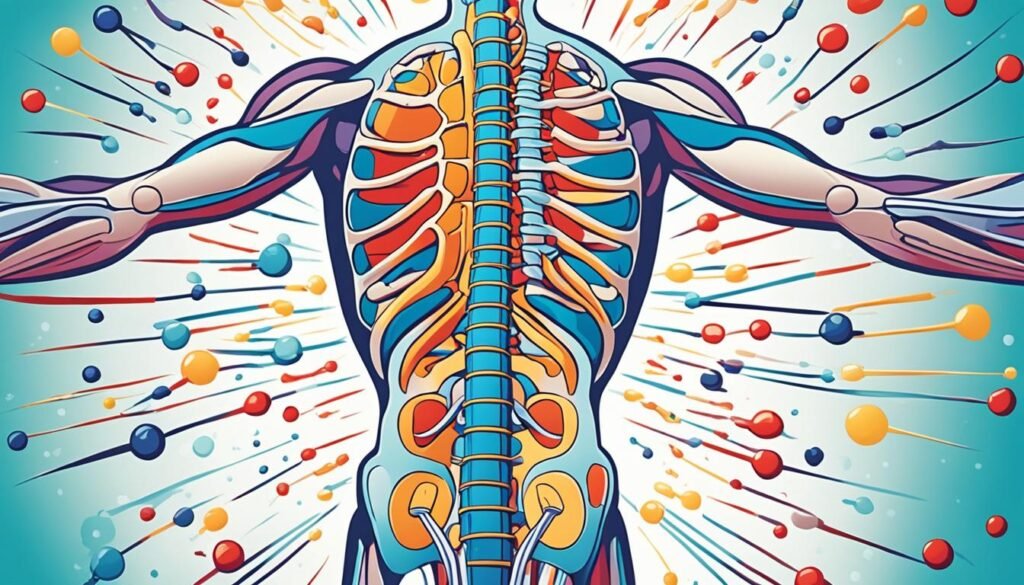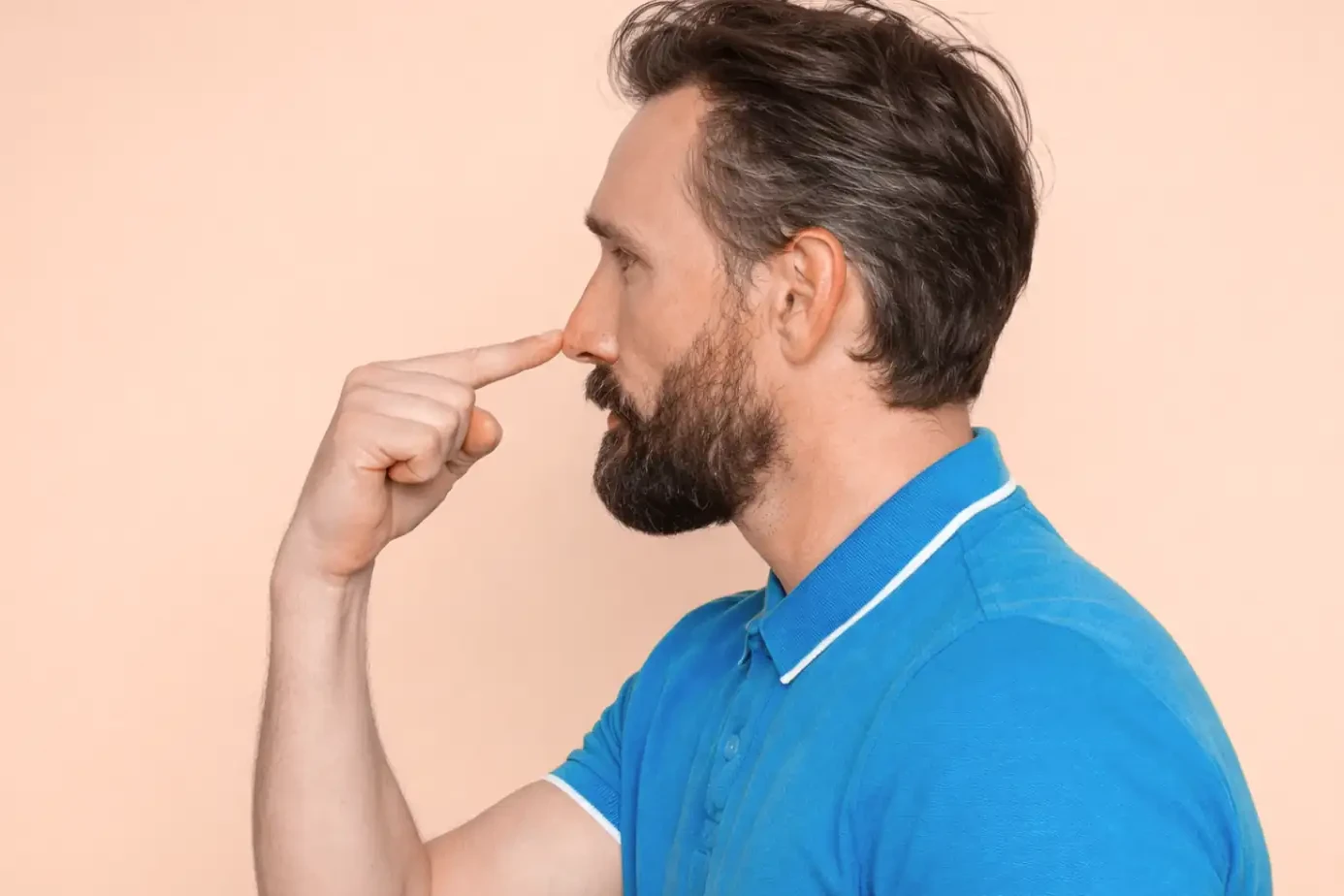Lumbar radiculopathy brings pain, numbness, and weakness to the lower back and legs. It’s a common issue seen by spine surgeons. About 3-5% of people might experience it.
This condition is mainly due to compressed or irritated nerve roots in the lower back. This can happen because of various issues like herniated discs or bone spurs.
Symptoms include sharp pain, burning feelings, or numbness that spreads down the leg. Proper diagnosis and treatment are key to helping patients feel better.
Table of Contents
ToggleWhat is Lumbar Radiculopathy?
Lumbar radiculopathy is a condition where a nerve root in the lower back is squeezed or irritated. This causes pain, numbness, and weakness down the leg. Patients often say the pain feels like electric shocks or burning.
Definition and Symptoms
Radiculopathy means pain spreads down the legs. A main reason for this may be something pressing on a nerve. In the lower back, this can happen where the nerve exits the thecal sac or as it goes through other areas.
Causes of Lumbar Radiculopathy
Many things can lead to lumbar radiculopathy. This includes disc problems, spondylolisthesis, and even cancers. As we grow older, our spines can wear down. This can cause problems like disc bulging or bone spurs, which squeeze nerves.
Infections and growths on the spine can also cause this condition. However, these are not as common.
Diagnosis of Lumbar Radiculopathy
The journey to diagnose lumbar radiculopathy starts with a thorough physical exam. This exam checks your muscles, your sense of feeling, and how your reflexes react. Doctors will also perform a special test called Lasegue’s sign.
The test is done while you’re lying down. Your leg is straight, with the knee stretched, and the head slightly bent forward. The doctor lifts your leg slowly. If you feel pain that shoots down your leg, it’s a sign of lumbar radiculopathy.
Imaging Tests
For a closer look, doctors use MRI scans of your lower back without contrast. These images are great for spotting any nerve compression. If they suspect conditions like a tumor, an infection, or if you had surgery before, they might use a contrast dye during the MRI.
Electrodiagnostic Studies
Electrodiagnostic tests, tests like EMG and NCV, are sometimes needed. These tests help the doctor tell if it’s radiculopathy or a different peripheral nervous system issue.

Non-Surgical Treatment Options
Many patients start with non-surgical ways to treat lumbar radiculopathy. They learn about it, do exercises, and stay active. Things like McKenzie exercises can help ease the symptoms at first.
Patient Education and Exercise
Teaching patients about their condition and staying active is key. They learn about their spine and what’s causing the issue. They also learn how lumbar radiculopathy exercises can lessen the pain. For activities, they are advised to try walking, swimming, or using the elliptical. These can strengthen their back and core.
Medications and Pain Injections
Doctors might prescribe drugs like NSAIDs or oral steroids to reduce pain and swelling. They can also use injections, like epidurals, to reduce symptoms for a while. These shots often include an anti-inflammatory and a pain blocker.
Surgical Decision-Making
When treatments that aren’t surgery don’t help, surgery can be looked at for lumbar radiculopathy patients. The period usually takes between four to eight weeks. This time allows for trying other ways to get better without surgery first.
Timing for Surgery
Deciding on surgery means looking at when the patient started feeling bad and how long that’s been. It’s best to wait four to eight weeks after trying things that aren’t surgery. This gives enough time to see if the patient gets better without an operation.
SPORT Trial Findings
The SPORT trial looked at 501 people with herniated lumbar discs, comparing surgery to non-surgery. Both groups got better a lot in two years, but surgery’s results were a bit better. However, the difference wasn’t big enough to be sure.
What’s important is that the SPORT trial talked about when surgery might be better than other treatments for some people.
Lumbar Radiculopathy Causes
Changes in tissues around the nerve roots often cause lumbar radiculopathy. This changes can make the spaces for nerve roots narrow. One common cause is a bulging or herniated disc. It happens when a spinal disc moves out of place or gets damaged, putting pressure on the nerves.
Herniated Discs
Herniated discs often lead to lumbar radiculopathy. When the interior of a disc bulges or ruptures through, it presses on nerve roots. This pressure causes pain, numbness, and tingling in the lower back and legs.
Bone Spurs
Bone spurs, which are extra bone growths, can also cause lumbar radiculopathy. They grow in certain areas, narrowing the foramina. This can then compress the nerve roots, leading to symptoms of radiculopathy.
Other Causes
Less common causes of lumbar radiculopathy include spinal ligaments getting thicker. Spinal infections and cancerous or noncancerous growths in the spine can also press against nerve roots.
Radiculopathy vs. Other Conditions
Radiculopathy can be tough, but knowing how it’s different from other issues is key. It often links to myelopathy, where the spinal cord is compressed. This happens when discs push on both nerve roots and the spinal cord. It causes severe problems like trouble walking, bad coordination, and even paralysis.
Radiculopathy’s symptoms might mix up with peripheral neuropathy’s, like in carpal tunnel syndrome. The crucial difference is that radiculopathy is pinching at nerve roots. But peripheral neuropathy hurts nerves in other parts of the body. Seeing a spine specialist is crucial to tell these issues apart and get the right diagnosis.
Surgical Treatment Options
When other treatments don’t work, some people might need surgery for lumbar radiculopathy. The main aim of surgery is to lessen the pressure on the nerve. This is done by making more space where the nerve roots leave the spine. It might mean taking out some of a disc or vertebrae to help the nerve heal.
A cervical posterior foraminotomy is a less invasive surgery. It helps by taking out bone or disc material to ease the pressure on the nerve. The type of surgery performed depends on what’s causing the radiculopathy. It also depends on what the patient needs.
There are different surgeries available for lumbar radiculopathy. These include discectomy, laminectomy, and fusion surgeries like posterior spinal fusion. Microdiscectomy is seen as the best for those with disc herniation only.
People who undergo less invasive surgeries might leave the hospital on the same day or within 24 hours. Those needing more complex fusion surgeries tend to stay longer, maybe 2 to 4 days.
Although surgery can really help some people, there are risks. This includes things like infection, nerve damage, and not fully healing after. The time it takes to recover can also vary, from 4 to 12 weeks.
Prevention and Risk Factors
Preventing lumbar radiculopathy is not always guaranteed. But, you can lower your risk by staying healthy. This means keeping your weight in check and being physically active. These habits reduce spine strain and your chance of getting herniated discs or bone spurs. Also, having good posture and lifting correctly can keep you from hurting your back.
Getting older is also a big risk for lumbar radiculopathy. The condition is often linked to the spine getting worn over time. Symptoms usually start in midlife, hitting men in their 40s and women from their 50s onwards. Women in jobs that are physically tough, like military service, face even more risk.
The main culprit behind lumbar radiculopathy is degenerative spondyloarthropathies. These issues can compress or irritate nerves in the lower back. Knowing these risk factors, you can act to lower your risk. Stay active, keep your weight steady, and be careful with your back to avoid this tough condition.
Anatomy and Pathophysiology
The spine is made of many vertebrae, with a spinal cord in the center. Nerve roots move out and go between the vertebrae to parts of the body. When these roots are squeezed or hurt, it causes radiculopathy. This can happen in the lower back, causing pain, numbness, and weakness in the leg. This is known as lumbar radiculopathy.
Compression might happen inside the thecal sac, when the root leaves it, as it goes through the foramina, or after it leaves. Pushing on the nerves from things like disc problems or bone spurs is usually why this happens.
Studies suggest that lumbar radiculopathy can come from problems with blood flow to the nerves. This can lead to less electrical signals moving through the nerve roots. It takes a lot of pressure to slow these signals down at first but not so much over time.
Less blood flow and trouble getting nutrients to nerve tissue can make the nerves not work right. Even a little bit of pressure can slow down the blood moving through the nerves. But, pressure by itself isn’t always the main reason for the pain in lumbar radiculopathy.
If nerves are pressed at two spots, it affects them more than if it’s just in one place. This means less blood flow and fewer nutrients can make the nerves work even worse. And that can cause problems in lumbar radiculopathy.
Epidemiology and Prevalence
Lumbar radiculopathy is a big issue for spine surgeons, affecting 3-5% of people. It’s common in both men and women, and age plays a big role. It often happens as we get older due to issues in the spine. Symptoms usually start in midlife. Men may start feeling them in their 40s, while women feel them a bit later, in their 50s and 60s.
In general, men are more often affected by lumbar radiculopathy. But, females have a higher risk in some groups, like those with tough jobs. The main cause is degenerative spondyloarthropathies. This can squeeze or irritate the nerve roots in your lower back.
Conclusion
Lumbar radiculopathy is a common problem that mainly affects the lower back and legs. It causes pain, numbness, and weakness. This issue happens when a nerve root in our lower back gets compressed or irritated. This can happen for various reasons like herniated discs, bone spurs, or other spinal problems.
It is important to catch and treat this early, offering relief. Doctors often start with treatments that don’t involve surgery. But sometimes, surgery is the best option.
By knowing why lumbar radiculopathy happens and how to treat it, doctors can help their patients better. This condition affects about 3%-5% of people, and it is more common as we get older. Women in physically demanding jobs face a higher risk. But usually, men are more likely to have this problem.
In the end, dealing with lumbar radiculopathy early is key. Good care from the beginning can really make a difference. With patients and doctors working together, we can improve life quality and solve this issue effectively.
FAQ
What is lumbar radiculopathy?
Lumbar radiculopathy happens when a nerve in your lower back gets pressed or irritated. This causes pain, numbness, and weakness in the leg.
What are the common causes of lumbar radiculopathy?
The top reasons for lumbar radiculopathy are herniated discs, bone spurs, and other spine issues. These can press or irritate the nerve roots in the lower back.
How is lumbar radiculopathy diagnosed?
To diagnose lumbar radiculopathy, doctors do a physical exam and use imaging tests like MRI. Sometimes they do electrodiagnostic studies as well.
What are the non-surgical treatment options for lumbar radiculopathy?
At first, treatment aims to avoid surgery. This can include learning about the condition, keeping active, doing certain exercises, taking meds, and getting pain shots.
When is surgical intervention considered for lumbar radiculopathy?
If other treatments don’t work after 4-8 weeks, surgery might be an option. The surgery type depends on what’s causing the issue and what works best for you.
How is lumbar radiculopathy different from myelopathy and peripheral neuropathy?
Radiculopathy is the nerve roots being pinched. Myelopathy is the spinal cord itself getting compressed. Peripheral neuropathy is when nerves outside the spinal cord get damaged.
Can lumbar radiculopathy be prevented?
It’s hard to always prevent lumbar radiculopathy. But, keeping a healthy weight, sitting and standing right, and lifting correctly can lower your odds of getting it.
What is the prevalence of lumbar radiculopathy?
Many people see a spine surgeon because of lumbar radiculopathy. It’s believed to affect 3-5% of people.
Source Links
- https://www.ncbi.nlm.nih.gov/pmc/articles/PMC6858271/
- https://www.ncbi.nlm.nih.gov/books/NBK430837/
- https://www.hopkinsmedicine.org/health/conditions-and-diseases/radiculopathy
- https://my.clevelandclinic.org/health/diseases/22564-radiculopathy
- https://www.atlasneurosurgery.com/blog/5-nonsurgical-treatments-for-lumbar-radiculopathy
- https://www.ncbi.nlm.nih.gov/pmc/articles/PMC10888666/
- https://www.ncbi.nlm.nih.gov/pmc/articles/PMC7080952/
- https://www.sciencedirect.com/science/article/abs/pii/S1356689X14001386
- https://www.neuroendomke.com/spine-conditions-and-treatments/lumbar-radiculopathy/
- https://www.cortho.org/spine/sciatica/sciatica-surgical-treatment/
- https://www.wheelessonline.com/issls/section-2-chapter-8-pathophysiology-of-lumbar-radiculopathy/
- https://www.ncbi.nlm.nih.gov/books/NBK546593/
- https://emedicine.medscape.com/article/95025-overview
About The Author

This article is medically reviewed by Dr. Chandril Chugh, Board-Certified Neurologist, providing expert insights and reliable health information.
Dr. Chandril Chugh is a U.S.-trained neurologist with over a decade of experience. Known for his compassionate care, he specializes in treating neurological conditions such as migraines, epilepsy, and Parkinson’s disease. Dr. Chugh is highly regarded for his patient-centered approach and dedication to providing personalized care.
→ Book a consultation to discover which remedies suit your needs best.





